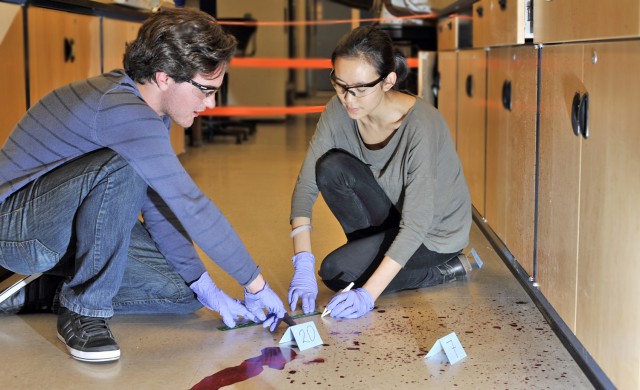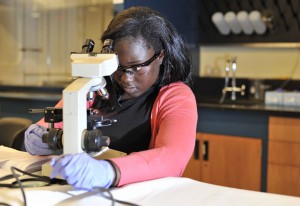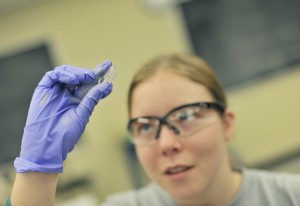Chemistry Class Teaches Hands-On Forensic Analysis

On the morning of June 22, Matt Donahue ’14 and and Pik-Tone Fung ’14 learned that a Wesleyan chemistry professor had been shot in the basement of Hall-Atwater Laboratory. Public Safety taped off the area around Room 078 and removed the body, leaving behind a blood-stained lab coat, a gun, two shell casings, a hand-written note from “Greg Mulligan,” a bloody bullet and an overturned chair. Small pools of blood collected under the victim and blood droplets freckled the nearby lab cabinets and counter.
The professor did owe $20,000 to Greg Mulligan. Was he murdered for not returning the money?
Although this was a mock crime scene, Donahue and Fung treated it seriously. For five weeks, the students, who were enrolled in the Summer Session course, CHEM 198 – “Forensics: The Science Behind CSI,” learned how to investigate and document crime scenes. During the five-week class, students learned how to collect crime-scene evidence, analyze ink in written documents, type blood, interpret how to test over-the-counter medications, sample and lift fingerprints, document a crime scene, interview witnesses and write and present a final report.

“There were no suspicious smells, footprints or tool marks found in the room, but there was one passive blood stain, far from the spatter, that was mysterious and may have suggested that someone tried to clean up the scene, or the spatter traveled very far,” Donahue noted in his observation. “We also found hair on the ground near the chair, a blue synthetic fiber in the lab coat, a paper towel with blood and gray residue, and a tiny fiber found on the gun’s trigger guard.”
For the course’s instructor, Andrea Roberts, visiting assistant professor of chemistry, the crime scene offered a way to give the students an enjoyable lab practical. The course had both lab and classroom components.
“They basically need to implement everything they learned in class by coming to a crime scene that I set for them, identifying the evidence, testing it in the lab and, based on autopsy reports and First Responder’s reports, try to interpret the evidence they find, identify a suspect or suspects and try to come up with a motive for the crime,” she explains. “They have to apply all that the things they learned in lecture and all of the techniques they learned in the lab to solve the crime.”

The students shared their findings in class on June 27.
At this particular scene, the students each took a role in the investigation. Fung worked as a sketch artists and blood analyst; Sean Kyle worked as an evidence technician; Darshdeep Hora photographed the scene and analyzed hair and fiber samples; and Alma Sanchez-Eppler oversaw the ballistics – or bullet projectile – analysis. Donahue, who served as the project’s lead investigator, also conducted finger print analysis from prints found on the room’s door, counter, a diet root beer can and vodka bottle.
After three days of tests, the group hypothesized that the professor either became intoxicated and shot himself twice, or the man who left the note – “Greg” – confronted the professor about a money loan, and shot the professor in the head. The students also suggested that Greg removed the professor’s left glove, put the gun in his left hand, and shot the professor in the head twice from the same point of entry to make the accident appear to be a homicide.
“It’s always fun to see what the students come up with and if they’re able to figure out who the perpetrators are,” says Roberts, who has taught the class more than six times. “In this case, they all did an excellent job.”

